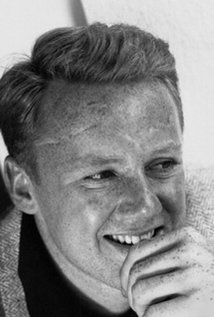
Van Johnson
Birthday:
25 August 1916, Newport, Rhode Island, USA
Birth Name:
Charles Van Dell Johnson
Height:
185 cm
Van Johnson was the well-mannered nice guy on screen you wanted your daughter to marry. This fair, freckled and invariably friendly-looking MGM song-and-dance star of the 40s emerged a box office favorite (1944-1946) and second only to heartthrob Frank Sinatra during what gossipmonger Hedda Hopper dubbed the "Bobby-Soxer Blitz" era. Johns...
Show more »
Van Johnson was the well-mannered nice guy on screen you wanted your daughter to marry. This fair, freckled and invariably friendly-looking MGM song-and-dance star of the 40s emerged a box office favorite (1944-1946) and second only to heartthrob Frank Sinatra during what gossipmonger Hedda Hopper dubbed the "Bobby-Soxer Blitz" era. Johnson's musical timing proved just as adroit as his career timing for he was able to court WWII stardom as a regimented MGM symbol of the war effort with an impressive parade of earnest soldiers. He may have been a second tier musical star behind the likes of Fred Astaire and Gene Kelly, but his easy smile, wholesome, boy-next-door appeal and strawberry-blond good looks earned him a solid shot at box-office stardom while the big boys (i.e., MGM stars) were off to war. When they returned, Johnson amiably relinquished his "golden boy" pedestal, but his popularity did not wane. In retrospect, his dramatic talent seemed overly scrutinized...for he was very capable. Besides, he worked another three decades on stage, screen and TV...and always as a star.Johnson was born Charles Van Dell Johnson in Newport, Rhode Island, the only child of Loretta (Snyder) and Charles E. Johnson. His paternal grandparents were Swedish, and his mother was of German, and a small amount of Irish, ancestry. Johnson endured a lonely and unhappy childhood as the sole offspring of an extremely aloof father (who was both a plumber and real estate agent by trade) and an absentee mother (she abandoned the family when he was three, the victim of alcoholism). A paternal grandmother helped in raising the young lad. Happier times were spent drifting into the fantasy world of movies, and he developed an ardent passion to entertain. Taking singing, dancing and violin lessons during his high school years, he disregarded his father's wish to become a lawyer and instead left home following graduation to try his luck in New York.Early experiences included chorus lines in revues, at hotels and in various small shows around town. A couple of minor breaks occurred with his 40-week stint in the "New Faces of 1936" revue (making his Broadway debut) and in a vaudeville club act (based around star Mary Martin) called "Eight Young Men of Manhattan" that played the Rainbow Room. He served as understudy to the three male leads of Rodgers and Hart's popular musical "Too Many Girls" in October of 1939 and eventually replaced one of them (actor Richard Kollmar left the show to marry reporter Dorothy Kilgallen.) He also formed a lifelong and career-igniting friendship with one of the other leads, Desi Arnaz. Johnson made an inauspicious film debut with Arnaz in Too Many Girls (1940) when the musical was eventually lensed in Hollywood, but he was cast in a scant chorus boy part. Following a stint on Broadway in "Pal Joey" in 1940, Warner Bros. signed Van to a six-month contract. He went on to co-star with Faye Emerson in Murder in the Big House (1942), but they dropped him quickly feeling that his acting chops were lacking. It was Arnaz's wife Lucille Ball, who had recently signed with MGM, who introduced Van to Billy Grady, MGM's casting head, and instigated a successful screen test.With the studio's top male talent off to war, Van served as an earnest substitute donning fatigues in such stalwart movies as Somewhere I'll Find You (1942) The War Against Mrs. Hadley (1942) and The Human Comedy (1943). Van also replaced actor/war pacifist Lew Ayres in the "Dr. Kildare/Dr. Gillespie" film series after Ayres was unceremoniously dumped by the studio for his unpopular beliefs. Stardom came, and at quite a price, for Van when he was cast yet again as a wholesome serviceman in A Guy Named Joe (1943). During the early part of filming, he was severely injured in a near-fatal car crash (he had a metal plate inserted in his skull, which instantly gave him a 4-F disqualification status for war service). Endangered of being replaced on the film, the two stars of the picture, Spencer Tracy (who became another lifelong friend) and Irene Dunne, insisted that the studio work around his convalescence or they would quit the film. The unusually kind gesture made Van a star following the film's popular release and resulting publicity. Van's career soared during the war years. His boyish charm and fair, attractive features made him the resident heartthrob and he rode on a crest of popularity not only in musicals (Two Girls and a Sailor (1944), Easy to Wed (1946)), but in airy comedies (Week-End at the Waldorf (1945)) and, of course, more war stories (Thirty Seconds Over Tokyo (1944)).When the big stars such as Clark Gable, James Stewart and Robert Taylor returned to reclaim post-war stardom, Van willingly resigned himself to second dramatic leads, but he remained a high profile musical star opposite the likes of June Allyson, Esther Williams and Judy Garland. He continued to demonstrate his dramatic skills in such well-regarded films as Command Decision (1948), State of the Union (1948), Battleground (1949), Brigadoon (1954) and The Caine Mutiny (1954). MGM's "golden age" phased out by the mid-1950s and, with it, Van's strong film career took a sharp decline. The studio released him after he co-starred with Elizabeth Taylor in The Last Time I Saw Paris (1954).While he continued to freelance and show strength in other pictures such as the English-made The End of the Affair (1955) with Deborah Kerr; Miracle in the Rain (1956) opposite Jane Wyman, The Bottom of the Bottle (1956) with Joseph Cotten, 23 Paces to Baker Street (1956) co-starring Vera Miles, Kelly and Me (1957) partnered with a dog, and Beyond This Place (1959), the bloom was falling off the rose. In the late 50s and early 1960s Van again capitalized on his musical talents by reinventing himself as a nightclub performer and musical stage star. He made a wonderful Harold Hill in several productions of "The Music Man" and graced a number of musical and light comedy vehicles on the regional and dinner theater circuits, including "Damn Yankees," "Guys and Dolls," "Bells Are Ringing," "On a Clear Day...," "Forty Carats," "Bye Bye Birdie," "There's a Girl in My Soup" and "I Do! I Do!" He never delved heavily into TV until the 1970s and then appeared on a number of shows, earning an Emmy nomination for his participation in the mini-series Rich Man, Poor Man (1976).In later years, he grew larger in girth but still continued to work. He earned respectable reviews after replacing Gene Barry as Georges in the smash gay musical "La Cage Aux Folles" in 1985. His last musical role was as Cap' Andy in "Show Boat" in 1991, and his last several movies were primarily filmed overseas in Italy and Australia. Van was married only once but it was constantly dissected under a microscope by the tabloids as well as the public. The marriage ended quite bitterly. Typically in the closet as a high-ranking actor of the 1940s, he was extremely close friends to MGM actor Keenan Wynn and his wife. However, Van wound up marrying Wynn's ex-wife, one-time stage actress Eve Abbott, right after the Wynns divorced (within four hours) in 1947. To an unsuspecting public, this seemed quite heartless of Van and Van's popularity suffered in its aftermath. In the meantime the tabloids continued to throw out innuendos that it was a studio-arranged "marriage". Whatever the intention, Van and Eve did have daughter Schuyler in 1948, and were a popular Hollywood couple before separating in 1962, after fifteen years of marriage. The marriage lingered on for another six acrimonious years before the final divorce decree. Van never married again and in later years Eve "spilled the beans" in a very bitter account of their marriage, which she admitted she went along with but maintained that it was an MGM-staged sham set up by Louis B. Mayer. Sadly, Van was estranged from his daughter Schuyler at the time of his death at age 92 at a senior living facility in Nyack, New York. In declining health, the popular actor had been residing there for several years. Show less «
[on Audrey Hepburn] She's a lady. When she participates in the Academy Awards, she makes all those starlets look like tramps. Thank you for ...Show more »
[on Audrey Hepburn] She's a lady. When she participates in the Academy Awards, she makes all those starlets look like tramps. Thank you for your class, Audrey, you're quite a lady. If anyone said anything derogatory about her, I'd push them in the river. Show less «
[MGM] was one big happy family and a little kingdom. Everything was provided for us, from singing lessons to barbells. All we had to do was ...Show more »
[MGM] was one big happy family and a little kingdom. Everything was provided for us, from singing lessons to barbells. All we had to do was inhale, exhale and be charming. I used to dread leaving the studio to go out into the real world, because to me the studio was the real world. Show less «
I am the luckiest guy in the world. All my dreams came true. I was in a wonderful business, and I met great people all over the world.
I am the luckiest guy in the world. All my dreams came true. I was in a wonderful business, and I met great people all over the world.
[on the vast number of soldiers he played on film during World War II] By war's end, I'd been in every branch of the service, all at MGM.
[on the vast number of soldiers he played on film during World War II] By war's end, I'd been in every branch of the service, all at MGM.
I never turned down anybody for an autograph. I think it's up to the fans; it's up to the public. No amount of photoplay magazines or layout...Show more »
I never turned down anybody for an autograph. I think it's up to the fans; it's up to the public. No amount of photoplay magazines or layouts puts you over the public unless the public buys you. Show less «
[on Joan Crawford and the book "Mommie Dearest"]: Some people said that Joan was better off being dead when Mommie Dearest came out, because...Show more »
[on Joan Crawford and the book "Mommie Dearest"]: Some people said that Joan was better off being dead when Mommie Dearest came out, because it would have broken her heart, and this way she was spared all that pain. I'm not one of those people. I totally disagree. They didn't know Joan. I wish the book had never happened. But if it had happened when Joan was still alive, and not too sick, I know her well enough to know she would have fought back, in her way. She had a quiet strength, but she was strong, and she was determined. Nothing wishy-washy about her. I think if she could have, Joan would have protected her life and her body of work against that viper she had taken to her bosom. Show less «

Holley

Daniel Hannigan, Daniel O'Brien, Elliot Robinson

Daniel Hannigan, Daniel O'Brien, Elliot Robinson
















